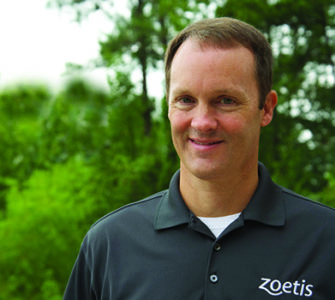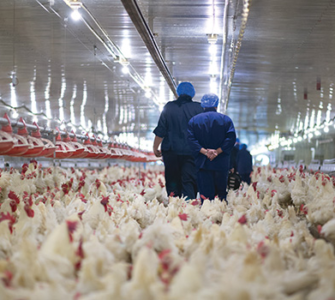Sanderson vet shares thoughts on managing elusive reovirus, other gut diseases
Part 1: Reovirus is always looking for an opportunity to change
Autogenous vaccines used in a reovirus vaccination program need to be updated relatively often to keep up with changes in the pathogen, David French, DVM, veterinarian at Sanderson Farms, told Poultry Health Today.
“Reovirus is a very unique virus in that it’s looking for an excuse to change and adapt and mutate…that’s what makes controlling it so difficult,” he said.
Traditionally, reovirus has been managed with a combination of commercial and autogenous vaccines. The protocol usually involves use of live and killed commercial vaccines; most producers also use an autogenous killed vaccine that’s specific to their operation, French said.
This is the type of vaccination program used by Sanderson Farms, he continued. The live vaccine protects the pullet, primes the immune system and generates memory cells that can improve response to the killed vaccines.
The commercial killed vaccines are readily available, don’t require isolation of an individual virus and are proven to be effective. However, in some cases they may not cover the full gamut of a reovirus field challenge. That’s when it’s helpful to have an autogenous vaccine available with the specific virus that’s causing trouble in that operation, he said.
The autogenous vaccine used may need to be changed relatively often because “…you could have the right vaccination program today and then next year it might be totally wrong,” French said.
Toward that end, producers must constantly evaluate their reovirus vaccination program by looking for signs of the disease in the broiler progeny — mainly early leg problems and malabsorption. To identify the reovirus strain needed for an autogenous vaccine, French isolates the virus in 7-day-old broiler flocks coming from a breeder flock suspected to be a common source of the problem.
Then the autogenous vaccine can be added or updated in the program, he continued.
He advised against sampling for reovirus from older diseased broilers because reovirus is so widespread in the environment that the strain isolated may not be the one causing the problem.
Part 2: Controlling coccidiosis, enteritis more challenging in today’s production schemes
Control of coccidiosis and necrotic enteritis is going to vary with the type of production system, which may be a “no antibiotics ever” (NAE) system, a “no shared class antibiotics” system or a conventional system, French said.
Ionophores are appropriate for a “no shared class” system, as they have no use in human medicine. “It’s a good example of a product that should be safe and efficacious and available for use, and yet if someone wants to make a claim that they have NAE, they are not permitted to use ionophores,” he noted.
The microbiota of the chicken is a complex population of organisms in the gut. Anything done to control one disease, like coccidiosis, has an impact on other diseases, like necrotic enteritis, French said.
“Anything that shifts the balance of the population dynamics in the gut of the bird may leave that bird more sensitive, more susceptible to other diseases and other problems that could follow. So, it’s a very complex thing to go to NAE or ‘no shared class’ antibiotics. It generates a lot of unintended consequences in the gut of the bird, which companies have to seek out and find a way to manage,” he warned.
French pointed out that Sanderson Farms has a conventional-production system. It can use all the tools available in the toolbox — including antibiotics — but there’s an expense every time those tools are used. Therefore, the company doesn’t use antibiotics if it can avoid it and has implemented some of the management strategies used in NAE production.
The main concern French has about NAE production is animal welfare. Some birds are inevitably going to get sick. If a company’s market is only NAE, there’s a tremendous pressure on veterinarians not to treat sick birds that should be treated, French said.
He believes there is a widespread misconception among the general public about how antibiotics are used in poultry production. “We’re not able to pick up each individual bird and treat them separately. We just don’t have that opportunity to separate out the sick birds from the ones that are healthy…we physically cannot do that,” he reiterated.
“It’s an educational mission for us, and we’re doing our best through advertising and marketing efforts to educate the public. But it’s a constant challenge because there are people that today don’t know where their food comes from. And they have no concept of how the food is handled in an animal agriculture facility,” French concluded.
Posted on March 11, 2019

















